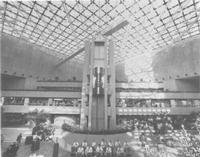


Chapter 6
I Construction During The Settlement Years
II The Use Of Timber As A Structural Material
III Structural Steel
IV Concrete Technology
V Housing
VI Industrialised Pre-cast Concrete Housing
VII Ports And Harbours
VIII Roads
IX Heavy Foundations
X Bridges
XI Sewerage
XII Water Engineering
XIII Railways
XIV Major Buildings
XV Airports
XVI Thermal Power Stations
XVII Materials Handling
XVIII Oil Industry
XIX The Snowy Mountains Scheme
XX The Sydney Opera House
XXI The Sydney Harbour Bridge
XXII Hamersley Iron
XXIII North West Shelf
Sources and References
Index
Search
Help
Contact us

Not all modern buildings have been without major problems; several buildings, including the Melbourne and Metropolitan Board of Works office building, constructed between 1969 and 1974, experienced problems with cladding. The MMBW building, some 23 stories high, was clad in basalt veneer, and problems with the veneer were discovered soon after erection. In a Ministerial Statement made in the Legislative Council on 4th May, 1983, the then Minister of Water Supply, The Hon. David White, M.L.C., said that most of these problems had their roots in the involved proposal to use basalt slabs or 'bluestone' as a non-structural veneer, for the facade of such a building. Further, ' . . . it is doubtful whether . . . care and scrutiny was applied either in relation to the suitability of the basalt concept or the actual fixing of the cladding.' Of the alternatives examined a system of anodised aluminium panels was considered to be the best solution. Panels were manufactured using fabricated frames made from extruded aluminium sections, with the anodised aluminium sheet being fixed to the frame using a system of welded studs and epoxy resins. The manufacture of some 15,000 panels incorporating some 300 varieties was executed in the Board's workshops. This method of manufacture incorporated techniques not previously used in Australia. In order to allow for horizontal expansion, each panel was fixed to sliding aluminium support rails, with the vertical expansion being accommodated by permitting the lower panel freedom to move in the rail supporting the panel above. All support rails were secured to the building using stainless steel bolts and anchors. The consulting architects for the re-cladding were Bates Smart & McCutcheon; the consulting engineers were Hardcastle and Richards.
High-rise office buildings are as much a manifestation of the twentieth century as were the Gothic cathedrals of the Middle Ages, and they account for many notable examples of modern Australian architecture. Two developments in Melbourne are particularly significant. Collins Place, near the old Parliament House, comprises two 46-storey towers, both square in plan although of unequal size. Arranged in staggered formation diagonally to the street, the smaller tower is entirely composed of offices; so also is the larger up to the 30th floor, but thereafter it provides 16 floors of a modern luxury hotel served by high-speed lifts from street level, with each room having unrivalled views over Melbourne. The rooms are arranged around a dazzling, mirror-filled central space, known as the Atrium, topped by a great glass roof. It echoes an even larger covered area at street level, termed the Great Space (Fig. 52), spanning 60 metres and incorporating several levels of shopping, with a semi-enclosed pedestrian plaza, open to Collins Street, but protected from the changeable Melbourne weather by a gigantic glass space-frame. (1981: architect: I. M. Pei (USA) in conjunction with Bates Smart & McCutcheon; the Great Space designed by Vincent Ponte USA).

Organisations in Australian Science at Work - Bates, Smart and McCutcheon; Hardcastle & Richards
People in Bright Sparcs - Haskell, Prof. J. C.
 |
Australian Academy of Technological Sciences and Engineering |  |
© 1988 Print Edition pages 385 - 387, Online Edition 2000
Published by Australian Science and Technology Heritage Centre, using the Web Academic Resource Publisher
http://www.austehc.unimelb.edu.au/tia/386.html